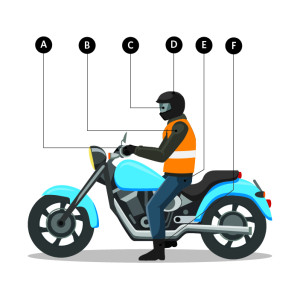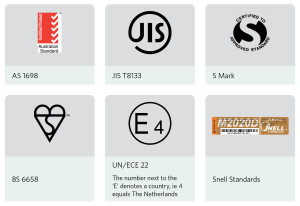It’s important to have the right gear and wear the right clothing to protect yourself while riding.
A - Gloves
B - Jacket
C - Eye protection
D - Helmet
E - Pants
F - Boots

Go to MotoCAP for information about good protective gear.
If you fall off your motorcycle, it’s likely your head will hit the road hard. This is why the law requires every rider and pillion passenger to wear an approved safety helmet securely fastened on the head. A good helmet can prevent serious injury and a full face helmet will give you even more protection.
An approved safety helmet will have a sticker on it showing it meets an approved safety standard. Don’t buy or wear any helmet that isn’t approved.
Your helmet should also:
You’ll need to replace your helmet if it’s cracked, has loose padding, frayed straps or exposed metal. If it’s damaged in any way, it may not be safe. Dropping it onto a hard surface can cause damage that can’t always be seen. For this reason, never buy a second-hand helmet.
Soap and water is the best way to clean a helmet. Never use petrol, methylated spirits or any other solvent to clean a helmet, as they can weaken the shell or the shock-absorbent lining. For the same reason, you should never use paints or stickers with unsuitable glues on a helmet.
The inside of your helmet needs looking after too. The foam can lose its shape from the oil and moisture on your head, making the helmet less safe. Buy a helmet with removable lining and wash it regularly.
Go to motocap.com.au to check their helmet testing to see how safe your helmet really is.
An approved motorcycle helmet complies with one or more of the approved international standards:
You can identify helmets that comply with approved standard by these markings:

Helmets complying with FMVSS 218 will be marked with the letters ‘DOT’. This standard is only acceptable for motorcycle helmets that have been manufactured and purchased in the United States.
When riding, you need to wear a face-shield, visor or goggles to protect your face and eyes from wind, dust, rain, insects and other debris.
To be effective, your face-shield, visor or goggles must:
If your eye and face protection gets smeared while riding, pull over to the side of the road to clean it as soon as it’s safe.
If your eye and face protection gets cracked, you may need to take it off or, in the case of visors, ride with the visor up. You should replace damaged visors or goggles as soon as possible.
You should never wear dark or tinted visors, goggles or glasses at night, as you must be able to see clearly.
Your clothes need to protect you if you crash, and protect you from bad skin grazing if you fall.
The right clothes can also:
Clothing that’s designed specifically for motorcycling will give you the best protection.
The wind can cause your body temperature to drop, slowing your reflexes and making it hard to concentrate. Even on fine days, the wind chill can affect you, and you could get hypothermia.
These are usually made of leather or wind and waterproof fabrics and are able to withstand abrasion. Often jackets have a removable thermal liner so you can adjust the level of warmth. Jackets should have armour built into them to protect your elbows, shoulders and back. Both jackets and pants should be a reasonably tight fit.
ImportantWear a reflective vest to help you be seen on the road. |
Gloves will give you a better hold on the hand grips. Your hands need to be warm, dry and protected if you fall off. You may need several pairs for summer and winter. Leather is good for protection but may not be waterproof.
Boots are the best footwear to wear when riding. Your boots should:
Don’t ride in running shoes, jandals or bare feet. Avoid shoes with rings or laces that could catch on the motorcycle.
More information on protective clothing is available on the Ride Forever website